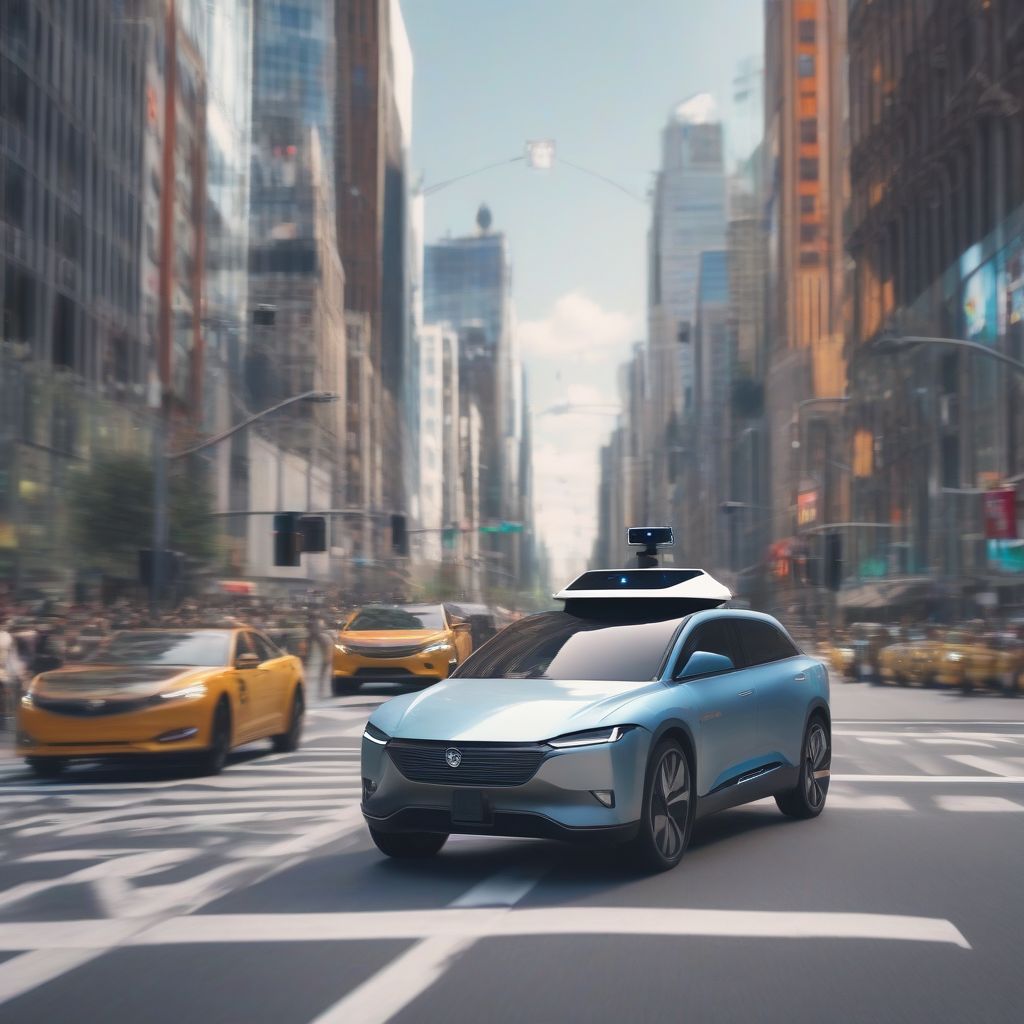Imagine a world where traffic jams are a distant memory, and the daily commute is spent catching up on emails or enjoying a good book. This is the promise of autonomous vehicle technology, a future where cars drive themselves, potentially revolutionizing transportation as we know it. But before we all hop in the backseat and enjoy the ride, there are legitimate safety concerns that need to be addressed.
The Dilemma of Trust: Can We Rely on Driverless Cars?
One of the most significant concerns surrounding autonomous vehicles is the question of trust. Can we, as a society, put our faith in machines to navigate complex traffic situations and make split-second decisions that impact human lives?
 Autonomous Vehicle Navigating Traffic
Autonomous Vehicle Navigating Traffic
While autonomous vehicles boast advanced sensors, algorithms, and machine learning capabilities, they are not immune to errors. Software glitches, unforeseen circumstances, and unpredictable human behavior can all pose challenges for even the most sophisticated self-driving systems.
Navigating the Unpredictable: How AVs Handle Unexpected Situations
A key concern is how autonomous vehicles will respond to unpredictable scenarios, such as sudden weather changes, unexpected obstacles in the road, or erratic behavior from other drivers.
“Autonomous vehicles excel in controlled environments, but the real world is anything but controlled,” says Dr. Emily Carter, a leading researcher in artificial intelligence and robotics. “Teaching a machine to anticipate and react to the infinite variables of human behavior and unpredictable situations remains a significant challenge.”
Current autonomous vehicle technology relies heavily on pre-programmed maps and algorithms, which may not always account for real-time changes or unexpected events. This raises concerns about the vehicle’s ability to adapt and make safe decisions in unforeseen circumstances.
The Ethical Crossroads: Moral Dilemmas in Autonomous Driving
Beyond the technical challenges, autonomous vehicles also present complex ethical dilemmas. In situations where an accident is unavoidable, how will the vehicle’s programming prioritize human safety? Who is responsible when an autonomous vehicle is involved in an accident – the manufacturer, the software developer, or the passenger?
These are not hypothetical scenarios but real-world concerns that policymakers, ethicists, and technologists are grappling with as autonomous vehicle technology advances.
Cybersecurity Concerns: Protecting Autonomous Vehicles from Hackers
As autonomous vehicles become more connected, they also become increasingly vulnerable to cyberattacks. A compromised system could lead to accidents, data breaches, or even the vehicle being used as a weapon.
Ensuring the cybersecurity of autonomous vehicles is paramount to building public trust and ensuring their safe deployment on our roads. Robust security protocols, encryption, and continuous monitoring are crucial to mitigating these risks.
The Path Forward: Building Trust and Ensuring Safety
Despite these concerns, the potential benefits of autonomous vehicles are undeniable. From increased mobility for the elderly and disabled to reduced traffic congestion and emissions, the technology holds the promise of transforming transportation for the better.
To fully realize this potential, however, we must prioritize safety at every stage of development and deployment. This requires collaboration between automakers, technology companies, regulators, and the public.
Key Steps to a Safer Autonomous Future:
-
Rigorous Testing and Regulation: Establishing comprehensive safety standards and testing protocols for autonomous vehicles, including simulations and real-world trials.
-
Cybersecurity Investment: Prioritizing cybersecurity research and development to protect autonomous vehicles from hacking and cyberattacks.
-
Ethical Frameworks: Developing clear ethical guidelines and regulations to address the moral dilemmas posed by autonomous driving.
-
Public Education and Engagement: Fostering public understanding and trust in autonomous vehicle technology through transparent communication and education initiatives.
The road to a fully autonomous future may be long and winding, but by addressing these safety concerns head-on, we can pave the way for a safer, more efficient, and more accessible transportation system for all.
The Future Is Shared: Navigating the Road Together
Autonomous vehicle technology has the potential to reshape our world, but its success hinges on our collective commitment to safety, transparency, and collaboration. By working together, we can harness the power of this technology to create a future where transportation is safer, smarter, and more sustainable for everyone.
[amazon bestseller=”autonomous vehicles”]
Let us know your thoughts on the safety of autonomous vehicles in the comments below! Share this article with your friends and family to join the conversation about the future of transportation.
